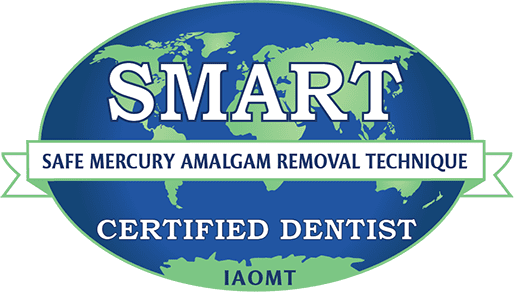Dr. Robert Rousseau
What precautions do you use for safe removal of
silver (aka Mercury) amalgam fillings?
The term silver fillings is a misnomer as they are nearly 50% mercury and hence should be called mercury fillings. The International Academy of Oral Medicine and Toxicology (IAOMT) recommends many precautions for safe mercury removal and we use most if not all of them. The patient rinses and swallows activated charcoal to absorb heavy metal toxins and their nose is covered with an oxygen mask to prevent breathing of mercury vapor through their nose. The patient, also, holds a vacuum near their mouth to minimize oral inhalation of mercury vapor. The dental assistant uses a 4 walled suction tip called a clean up suction which collects more than 90% of the vapor. This is sometimes used in conjunction with a rubber dam or either can be used separately. To clean the room air a mercury vapor ionizer and room air filter run throughout the procedure time. To keep mercury sludge from entering the waste water/environment we have an amalgam separator which gets sent in yearly for proper hazardous waste disposal. In addition the dentist and assistant wear gas masks. There is a fee for this protocol over and above the restoration cost.
Does your office use fluoride?
Dental product manufacturers put fluoride in a lot of dental products and their use is minimized here. Traditional fluoride treatments in trays are not done and are replaced by MI (remineralization) paste in trays. MI paste has calcium and phosphorous to help remineralize teeth without ingesting the neurotoxin/carcinogen fluoride. Toothpastes, gums and ‘mints’ with xylitol are recommended as decay preventives, also. A good systemic plant derived mineral supplement is recommended as well.
Are ‘non-metal’, tooth colored, restorations safe?
Most ceramic and composite tooth colored restorations have metal oxides in them for strength and so they can be seen on x-rays. Some composite materials have bisphenol-A in them as well. For chemically sensitive people or those who have concerns about restoration compatibility it is best to have a material compatibility test done. Either a blood test like the Clifford Reactivity test or an acupuncture meridian stress test like e mapping or electrodermal screening can be performed prior to having work done. These tests show which dental materials are suitable for use.
What is non-surgical periodontal treatment?
Periodontal disease is an infection with potential for systemic ramifications including Diabetes, heart attack, and stroke. If periodontal disease is suspected, a sample of your plaque is gathered and placed on a microscope slide to be viewed under a microscope. This allows the Dentist and Hygienist to analyze the types of microbes present and their level of activity. It helps them set your treatment regimen as well. Most of the in office and home care treatments are aimed at killing those microbes. Oral irrigators with anti-microbial irrigants as well as anti-microbial toothpastes and rinses are part of this regimen. Dental soft tissue lasers help kill the microbes deep in periodontal pockets also. The hygienists use purified, ozonated water when irrigating before and after scaling and use nano-silver water when using ultrasonic scalers to help decrease the number of pathogens under the gums. Periodontal supplementation to strengthen gums and support bone are used also.
What is the difference between Invisalign and traditional braces?
Traditional braces get bonded onto the teeth and metal wires are used to move teeth to a new position. Most brackets are made of metal although there are some ceramic brackets. The wires are metal, however. The dentist is in control of how the teeth move by bracket placement, wire sizes and shapes, and placing bends and curves in the wires plus the patient cannot remove them.
Invisalign is a series of plastic trays that fit snugly on the teeth and are changed every two weeks. They are removed for eating and cleaning giving the patient control of the outcome because if the aligners are not worn the teeth will not move as expected. This can lead to increased costs or wearing braces.
Is it safe to get a root canal?
This is a complicated and complex question and it depends on your systemic health,family history of illness and which tooth is involved. Dentists are trained to save teeth and root canals can do that for many years if properly restored. However, endodontically treated teeth are dead body parts and as such can produce some of the most virulent toxins known. Patients are educated about the pros and cons of saving teeth with root canals versus extracting them and having to replace them with partial dentures, bridges or implants. All options are discussed and a careful informed decision is made.
Dr. Tom McGuire’s ‘Mercury: The Poison in Your Teeth’ Video provides conclusive proof that not only do amalgam silver fillings release toxic mercury vapor – but that the common act of brushing just one amalgam filling will release more mercury vapor than is allowed by governmental regulatory agencies at the workplace!


Discover more about the “Safe Mercury Amalgam Removal Technique.”